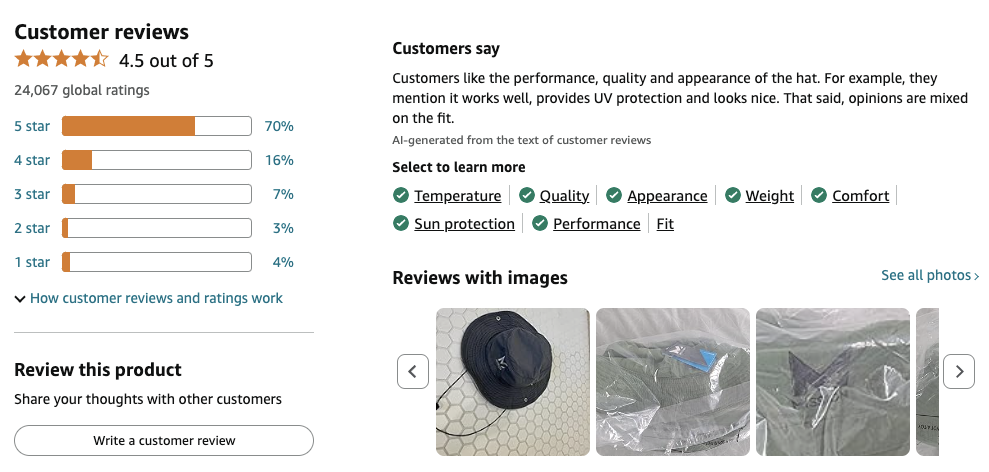Happy Summerween! If you’re a marketer, you’re probably celebrating by sipping on a Pumpkin Spice Latte and prepping for the busiest shopping season of the year.
Of course, we’re talking about Black Friday and Cyber Monday (BFCM). And today, we’re focusing on a strategy that often goes overlooked, even though it can have a significant impact on sales: customer reviews.
Reviews are a powerful tool, as they offer potential customers real insights into your products or services. However, not all reviews are created equal.
How you handle and display reviews can make a big difference in your success, both during the BFCM weekend and year-round. Here are ten research-backed strategies to help you effectively manage and leverage customer reviews.
Sections
1. Ask at the right time
Timing is important when asking for reviews. Asking for a review immediately after purchase can put customers off and lead to fewer reviews. Instead, wait at least 10 days before asking for a review.
This delay gives customers enough time to actually use and evaluate the product, so they’re more likely to a) leave a review and b) leave a review that’s thoughtful and useful for other shoppers.
2. Get better reviews
We’re not just talking about positive reviews, although those are always nice. Rather, it’s important to get meaty, thoughtful reviews. Deeper reviews not only give your customers the kind of information they need to make a purchasing decision, but they can help your SEO efforts, by adding more keyword-rich content to your product pages. Follow these tips for stronger reviews.
- Ask shoppers to compare your product to others. Reviews that include comparisons, such as “This kept my toddler entertained way longer than the toy sold by [your competitor],” can increase sales by up to 26%, according to a marketing study. These reviews not only highlight the positive aspects of your product but also provide a benchmark against competitors. Interestingly, even negative comparisons were shown to provide helpful information for shoppers.
- Launch new products with reviews. Shoppers are wary of being the first to try a product with 0 reviews. Prior to launch, share samples of your product with customers and ask them to write a review. This helps ensure your product goes live with reviews. Plus, since they received a product for free, they are more likely to write a positive review.
- Display a positive review first. The order in which reviews are displayed can influence purchasing decisions. Put shoppers in a positive state of mind by displaying at least one positive review first before showing others.
Pro Tip: Speaking of negative reviews, there’s no need to be afraid of them. Consumers find perfect 5-star ratings to be a bit suspicious, and studies show that a rating between 4.2–4.5 stars is the sweet spot when it comes to driving sales.
3. Get more reviews
Sending post-purchase emails is a great way to regularly generate reviews, but it’s only the first step. Another proven method for generating reviews is by incentivizing customers to leave them. Offering small incentives like discounts, free products, or sweepstakes entries can significantly increase the number of reviews you collect.
Just don’t ask directly for positive reviews, as that can backfire. Remember: negative reviews can be a good thing!
4. Include AI overviews
Incorporating AI-generated overviews at the top of your reviews can significantly enhance the customer experience by providing quick insights. Here’s an example from Amazon:

These AI overviews analyze and synthesize information from numerous reviews into a digestible summary, so customers can make faster, more informed decisions without having to read through dozens of reviews. This not only saves time for shoppers but it also increases their confidence in their purchase, leading to higher conversion rates.
5. Respond to all of your reviews
Responding to reviews, whether positive or negative, shows customers that you care about their feedback. Seeing this kind of engagement from a business can help potential customers view your business more positively, reducing their hesitation to purchase. And for negative reviews, it can turn a dissatisfied customer into a loyal one.
According to a BrightLocal survey, consumers are 41% more likely to shop with a business that responds to all of its reviews than a business that doesn’t respond to any.
Get more value from customer reviews
Implement the strategies above, and you’ll be ready to handle reviews not just during the Black Friday/Cyber Monday weekend but all year round. For personalized advice on how to build trust, drive sales, and get more from your marketing efforts, contact Your Marketing People.







